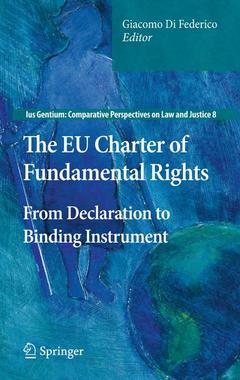Description
The EU Charter of Fundamental Rights, 2011
From Declaration to Binding Instrument
Ius Gentium: Comparative Perspectives on Law and Justice Series, Vol. 8
Coordinator: Di Federico Giacomo
Language: English
Subjects for The EU Charter of Fundamental Rights:
Keywords
Accession ECHR; Candidate Countries; Consitutional Courts; Democracy; Due Process; EU Charter; EU Legal Order; EU Member States; EU policies; Europe; European Court of First Instance; European Court of Human Rights; European Parliament; Fair Trial; Foreign Policy; Freedom; Fundamental rights; International Trade; Justice; Legal Pluralism; Lisbon Treaty; Res Republica; Rights Protection; Rights of Defence; Security; Security Policy; Social Rights; Union Citizenship
Publication date: 01-2013
320 p. · 15.5x23.5 cm · Paperback
Publication date: 12-2010
320 p. · 15.5x23.5 cm · Hardback
Description
/li>Contents
/li>Comment
/li>
These books may interest you

EU Constitutional Law 201.51 €



